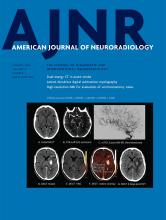Abstract
BACKGROUND AND PURPOSE: Moyamoya is a progressive steno-occlusive arteriopathy. MR imaging assessment of cerebrovascular reactivity can be performed by measuring the blood oxygen level–dependent cerebrovascular reactivity response to vasoactive stimuli. Our objective was to determine whether negative blood oxygen level–dependent cerebrovascular reactivity status is predictive of ischemic events in childhood moyamoya.
MATERIALS AND METHODS: We conducted a retrospective study of a consecutive cohort of children with moyamoya who underwent assessment of blood oxygen level–dependent cerebrovascular reactivity. The charts of patients with written informed consent were reviewed for the occurrence of arterial ischemic stroke, transient ischemic attack, or silent infarcts. We used logistic regression to calculate the OR and 95% CI for ischemic events based on steal status. Hazard ratios for ischemic events based on age at blood oxygen level–dependent cerebrovascular reactivity imaging, sex, and moyamoya etiology were calculated using Cox hazards models.
RESULTS: Thirty-seven children (21 female; median age, 10.7 years; interquartile range, 7.5–14.7 years) were followed for a median of 28.8 months (interquartile range, 13.7–84.1 months). Eleven (30%) had ischemic events, 82% of which were TIA without infarcts. Steal was present in 15 of 16 (93.8%) hemispheres in which ischemic events occurred versus 25 of 58 (43.1%) ischemic-free hemispheres (OR = 19.8; 95% CI, 2.5–160; P = .005). Children with idiopathic moyamoya were at significantly greater risk of ischemic events (hazard ratio, 3.71; 95% CI, 1.1–12.8; P = .037).
CONCLUSIONS: Our study demonstrates that idiopathic moyamoya and the presence of steal are independently associated with ischemic events. The use of blood oxygen level–dependent cerebrovascular reactivity could potentially assist in the selection of patients for revascularization surgery and the direction of therapy in children with moyamoya.
ABBREVIATIONS:
- BOLD =
- blood oxygen level–dependent
- CVR =
- cerebrovascular reactivity
- HR =
- hazard ratio
- IQR =
- interquartile range
- © 2020 by American Journal of Neuroradiology












